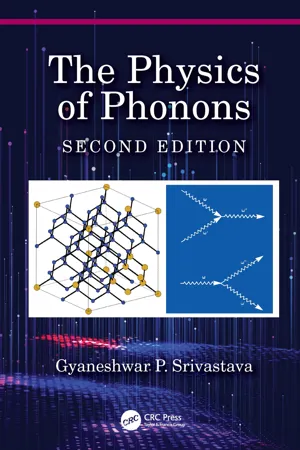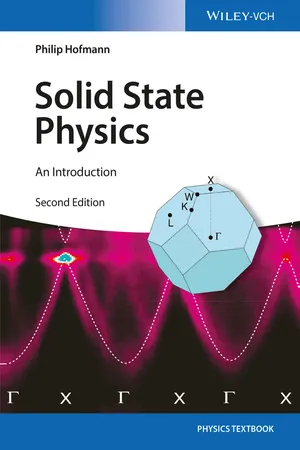Physics
Lattice Translation Vectors
Lattice translation vectors are a set of vectors that define the periodicity and arrangement of points in a crystal lattice. They represent the smallest repeating unit in a crystal structure and are used to describe the spatial arrangement of atoms or molecules in a crystal. These vectors are essential for understanding the symmetry and properties of crystalline materials.
Written by Perlego with AI-assistance
Related key terms
Related key terms
1 of 4
Related key terms
1 of 3
8 Key excerpts on "Lattice Translation Vectors"
- eBook - ePub
One-Dimensional Metals
Conjugated Polymers, Organic Crystals, Carbon Nanotubes and Graphene
- Siegmar Roth, David Carroll(Authors)
- 2015(Publication Date)
- Wiley-VCH(Publisher)
translational invariance of the crystal lattice and of the laws governing the physics within a crystal.Once the most simple, primitive lattice structure has been determined, it is important to realize how many possibilities exist for distinctively different lattices. Different lattices in this context are described by the different symmetry operations that will take the lattice into itself. This is governed by the ratio of lengths in lattice parameters as well as the angles in the lattice. Therefore, the three-dimensional analog of our rectangular lattice mentioned above, with , is a cubic lattice. This lattice has a number of symmetry operations – rotations, translations, reflections, that when performed on this lattice leaves the lattice unaltered. However, in lattices of lower symmetry, the lengths of the elementary cell might differ, ; also the angles between the axes do not need to be 90°. This means that an entirely different set of symmetry operations leaves the lattice unaltered.When the whole set of invariant symmetry operations: rotations and translations on a set of primitive lattice points are considered, they form a mathematical point group. An enumeration of all the possible lattice point groups can be made – which means there are only a finite number of primitive lattice arrangements expressing unique symmetries, that can exist – regardless of the values of the lattice parameters and angles. (Bravais lattices are said to be “equivalent” if they have isomorphic space symmetry groups.) These distinct groups are listed in Ashcroft and Mermin [1] as well as several other solid-state physics texts. In fact, in three-dimensional space, there are 14 possible symmetry groups, or symmetry variations of this most simple lattice. But in two dimensions, there are only 5 such symmetry groups allowed. In zero and one dimension, there is only one type of Bravais or primitive lattice. - eBook - ePub
Solid-State Chemistry
A Modern Approach
- Ashok Kumar Jha(Author)
- 2023(Publication Date)
- Apple Academic Press(Publisher)
Three-dimensional periodic arrangement of atoms gives rise to a crystal. When crystallization occurs, identical building blocks add continuously to form a three-dimensional network. It has been discovered by mineralogist that the index numbers of orientations of the crystal faces are integers. The periodic array of similar particle gives rise to the law of integral indices.________________ Solid-State Chemistry: A Modern Approach. Ashok Kumar Jha, PhD (Auth.) © 2023 Apple Academic Press, Inc. Co-published with CRC Press (Taylor & Francis)The lattice describes the structure of crystals in which atoms are attached to every lattice point. The basis is formed from the group of atoms. The repetition in space gives rise to the crystal structure.3.2 Lattice Translation Vectors
The lattice may be defined having three fundamental translation vectors a1 , a2 , a3 such that atomic arrangement remains unaltered from the point r(3.1)r ′= r +u 1a 1+u 2a 2+u 3a 3where u1 , u2 , u3 are arbitrary integers. The set of points r′ defined by (i) for all u1 , u2 , u3 defines a lattice.Thus, it may be said that a lattice is a regular arrangement of atoms or ions in space.Lattice + basis = crystal structurePrimitive translation vectors are used to define the crystal axes. The crystal axes a1 , a2 , a3 form three adjacent edges of a parallelepiped. Any two lattice points are connected by a vector of the form given below:T =u 1a 1+u 2a 2+u 3a 33.3 Primitive Lattice Cell or Unit Cell
A primitive cell is a type of cell or unit cell or minimum-volume cell. The primitive cell always has the same number of atoms.(a) Unit cell in two dimensionsIf the unit cell is a simple cubic and lattice points are at each of eight corners, each lattice point is shared among eight cells.(b) Primitive cell or unit cell in three dimensionsThe number of atoms in a unit cell in a simple cubic is8 ×1 8= 13.3.1 Three-Dimensional Lattice Types
Cubic, hexagonal, trigonal, tetragonal, orthorhombic, monoclinic, and triclinic are the seven basis unit cells. Table 3.1 represents lattice types in three dimensions.Table 3.1 The Seven Crystal System.S. No. - Javier E. Hasbun, Trinanjan Datta(Authors)
- 2019(Publication Date)
- CRC Press(Publisher)
[ 9 ]). The dots are thought of as the reciprocal space version of the real crystal. Reciprocal space is also referred to as Fourier space. Each dot in reciprocal lattice space is connected to each other by a reciprocal lattice translation vector denoted by G →. Just as a real space translation vector T → of Chapter 1 is represented in terms of real space fundamental lattice vectors; i.e., T → = u 1 a 1 → + u 2 a 2 → + u 3 a 3 →, (2.3.5) the reciprocal lattice translation vector also has a similar representation. It is written in the form G → = v 1 b 1 → + v 2 b 2 → + v 3 b 3 →, (2.3.6) where the v i ′ s are integers and b 1 →, b 2 →, b 3 → are fundamental reciprocal lattice vectors which are related to the fundamental lattice vectors a 1 →, a 2 →, a 3 → of the real crystal as we will see later. We now proceed to study how the reciprocal lattice vectors play an important role in exploiting crystal periodic properties. In particular, we will employ the periodic property of the atomic electron concentration in a crystal. 2.3.1 Electron Concentration and Reciprocal Lattice Vectors in 1-D A crystal is invariant under any translation of the form of Equation 2.3.5. Similarly any local property of the crystal is invariant under T. One example of this is the charge concentration or electron number density. Let the electron number density be n (r →), which is a periodic function of r → with periods a 1 →, a 2 →, a 3 → in the direction of the crystal axes. We have n (r → + T →) = n (r →) ; (2.3.7) that is, the electron concentration at position r → + T → is the same as that at position r →. Let’s work in one-dimension first, later we will extend the results to three dimensions. Consider n (x) to be of period a in the x -direction as shown in Figure 2.3.7. Figure 2.3.7: An anharmonic function of x is shown as a one-dimensional model of a crystal’s electron distribution with period a. The electron distribution follows the periodic atomic distribution- Emil Zolotoyabko(Author)
- 2021(Publication Date)
- Wiley-VCH(Publisher)
Auguste Bravais):(1.1)The nodes,r, of Bravais lattice are produced by linear combinations of three non-coplanar vectors,sa, called translation vectors. The integer numbers in Eq. (1.1) can be positive, negative, or zero. Atomic arrangements within every crystal can be described by the set of analogous Bravais lattices.1, a2, a3Classification of Bravais lattices is based on the relationships between the lengths of translation vectors, |a| = a, |1a| = b, |2a| = c and the angles, α, β, γ, between them. In fact, all possible types of Bravais lattices can be attributed to seven symmetry systems:3Triclinic: a ≠ b ≠ c and α ≠ β ≠ γ;Monoclinic: a ≠ b ≠ c and α = β = 90°, γ ≠ 90°; in this setting, angle γ is between translation vectorsa1(|a1| = a) anda2(|a2| = b); whereas the angles α and β are, respectively, between translation vectorsa2^a3anda1^a3;Orthorhombic : a ≠ b ≠ c and α = β = γ = 90°;Tetragonal: a = b ≠ c and α = β = γ = 90°;Cubic: a = b = c and α = β = γ = 90°;Rhombohedral: a = b = c and α = β = γ ≠ 90°;Hexagonal: a = b ≠ c and α = β = 90°, γ = 120°.A parallelepiped built by the aid of vectorsa1,a2,a3is called a unit cell and is the smallest block, which being duplicated by the translation vectors allows us to densely fill the 3D space without voids.Translational symmetry, however, is only a part of the whole symmetry in crystals. Atomic networks, described by Bravais lattices, also possess the so-called local (point) symmetry, which includes lattice inversion with respect to certain lattice points, mirror reflections in some lattice planes, and lattice rotations about certain rotation axes (certain crystallographic directions). After application of all these symmetry elements, the lattice remains invariant. Furthermore, rotation axes are defined by their order, n. The latter, in turn, determines the minimum angle, , after rotation by which the lattice remains indistinguishable with respect to its initial setting (lattice invariance). In regular crystals, the permitted rotation axes, i.e. those matching translational symmetry (see Appendix 1.A ), are twofold (180°-rotation, n = 2), threefold (120°-rotation, n = 3), fourfold (90°-rotation, n = 4), and sixfold (60°-rotation, n = 6). Of course, onefold, i.e. 360°-rotation (n = 1), is a trivial symmetry element existing in every Bravais lattice. The international notations for these symmetry elements are: – for inversion center, m – for mirror plane, and 1, 2, 3, 4, 6 – for respective rotation axes. We see that fivefold rotation axis and axes of the order, higher than n = 6, are incompatible with translational symmetry (see Appendix 1.A- eBook - ePub
- Richard J. D. Tilley(Author)
- 2020(Publication Date)
- Wiley(Publisher)
Chapter 2 Lattices, Planes and DirectionsHow does a crystal lattice differ from a crystal structure?What is a primitive unit cell?What are Miller‐Bravais indices used for?The development of the idea of a lattice was amongst the earliest mathematical explorations in crystallography. Crystal structures and crystal lattices are different, although these terms are frequently (and incorrectly) used as synonyms. A crystal structure is built of atoms. A crystal lattice is an infinite pattern of points, each of which must have the same surroundings in the same orientation. A lattice is a mathematical concept.All crystal structures can be built up from a lattice by placing an atom or a group of atoms at each lattice point. The crystal structure of a simple metal and that of a complex protein may both be described in terms of the same lattice, but whereas the number of atoms allocated to each lattice point is often just one for a simple metallic crystal, it may easily be 1000 for a protein crystal. The group of atoms associated with each lattice point is called the motif (or sometimes the basis).2.1 Two‐dimensional Lattices
In two dimensions, if any lattice point is chosen as the origin, the position of any other lattice point is defined by the vector P(uv):(2.1)where the vectors a and b define a parallelogram and u and v are integers. The parallelogram is the unit cell of the lattice, with sides of length a and b. The coordinates of the lattice points are indexed as u, v (Figure 2.1 ). Standard crystallographic terminology writes negative values as and (pronounced u bar and v bar). To agree with the convention for crystal systems given in Table 1.1 , it is usual to label the angle between the lattice vectors as γ. The lattice parameters are the lengths of the axial vectors and the angle between them, a, b, and γ. The choice of the vectors a and b, which are called the basis vectors - eBook - ePub
- Timothy S Fisher(Author)
- 2013(Publication Date)
- WSPC(Publisher)
in 3D:whereand ki are integers, and the denominator in Eq. (1.10) is the unit cell volume.Once the vectors are known, the reciprocal space can be populated with discrete points. We will focus on 2D graphene here. Analysis of the primitive translational vectors in Eq. (1.4) in the context of Eq. (1.8) reveals that we must have and and thatThe constants C1 and C2 must be equal to preserve the generality of Eq. (1.8) , and given the magnitude of the vectors we find:The resulting lattices, both direct (a) and reciprocal (b), for graphene are shown in Fig. 1.11 , as well as the respective translational vectors and the so-called 1st Brillouin zone, which is hexagonal in shape. The reciprocal lattice’s primitive cell (i.e., 1st Brillouin zone) is established by connecting lattice points with lines, which then define the shaded region of 2D space closest to a given lattice point.Fig. 1.11 (a) Direct graphene lattice. (b) Reciprocal graphene lattice. The primitive cell of the reciprocal lattice is the 1st Brillouin zone. Translation vectors of both lattices are also depicted.Reciprocal space is often termed ‘k-space’, and we will use the terms interchangeably. Reciprocal space is also useful in defining directions in a crystal. For a given real-space lattice plane, the Miller indices (k1 k2 k3 ) are vector coordinates (see Eq. (1.12) ) of the shortest reciprocal lattice vector normal to the plane. The Miller indices should not be confused with the primary directions in the real-space lattice, which are denoted by square brackets [xyz - eBook - ePub
- Gyaneshwar P. Srivastava(Author)
- 2022(Publication Date)
- CRC Press(Publisher)
1 Elements of Crystal SymmetryDOI: 10.1201/9781003141273-1In this chapter an introduction to crystal symmetry is presented. Some of the results will be required for the rest of the book. The discussion is intended to be brief, and the reader is recommended to consult further literature for more details. References used in preparing the presentation in this book are, among others, Heine (1960) , Bhagavantam (1966) , Morgan (1969) , Mariot (1972) ,Boardman et al (1973), Callaway (1974) , Joshi (1982) , Burns (1985) and Kittel (1986) .1.1 DIRECT LATTICE
A lattice is defined as an infinite regular array of points in which all points have identical surroundings. As a point is a mere realisation, a lattice is just a mathematical construction. From a chosen point, the position vector of another point of a three-dimensional lattice is given by a translation vectorT =(1.1)n 1a 1+n 2a 2+n 3a 3,whereand n3 are any integers, andn 1,n 2anda 1,a 2a 3are three independent primitive translation vectors. The parallelepiped formed byanda 1,a 2a 3, which contains one lattice point, is called a primitive unit cell. As all points have identical surroundings, the whole space can be generated by suitable translations of the primitive unit cell. Therefore, the essential features of a lattice can be extracted from its primitive unit cell.A cell or parallelepiped which contains more than one lattice point is called a non-primitive unit cell.A primitive unit cell in the shape of a parallelepiped defined byanda 1,a 2a 3has a volume equal to the Wigner–Seitz cell, or proximity cell, which is constructed as follows. Choose a lattice point and draw lines joining all neighbouring points. Construct perpendicular planes bisecting these planes. The smallest volume thus enclosed is the Wigner–Seitz cell.A total of 14 distinct types of three-dimensional lattices can be realised. These are known as the 14 Bravais lattices. For convenience, these are grouped into seven lattice systems - eBook - ePub
Solid State Physics
An Introduction
- Philip Hofmann(Author)
- 2015(Publication Date)
- Wiley-VCH(Publisher)
4 Thermal Properties of the LatticeIn this chapter, we discuss some thermal properties of solids such as their heat capacity, thermal conduction, thermal expansion, and melting. For now, we only consider the contribution of the lattice, that is, the effects caused by the motion of the atoms around their equilibrium position. For some thermal effects, the motion of the free electrons in metals can be very significant (e.g., thermal conduction), but we neglect this for now and come back to it in the next two chapters.4.1 Lattice Vibrations
The atoms in a crystal can vibrate around their equilibrium position. The restoring force can be derived from the interatomic potential, as expressed in the Taylor series (3.11 ). In most cases, it is sufficient to assume a linear restoring force, considering only the first three terms in the series. This leads to a description of the lattice vibrations as harmonic oscillators and is therefore called the harmonic approximation.4.1.1 A Simple Harmonic Oscillator
When inspecting the interatomic potential in Figure 2.1 and the Taylor series for the potential (3.11 ), one might be tempted to describe the vibrations of a solid with N atoms simply as 3N independent harmonic oscillators. The factor of 3 comes from the three different directions the atoms can oscillate in. While this is clearly much too simple (the oscillators are all coupled to each other), it is surprising how far one gets with this picture.If the force constant is equal to in (3.11 ) and x is the displacement from the equilibrium position (for convenience, we set the origin of the coordinate system such that a in (3.11 ) is zero), the equation of motion is4.1where M is the mass of the vibrating atom. This leads to a harmonic motion with the frequency 1
Index pages curate the most relevant extracts from our library of academic textbooks. They’ve been created using an in-house natural language model (NLM), each adding context and meaning to key research topics.
Explore more topic indexes
Explore more topic indexes
1 of 6
Explore more topic indexes
1 of 4







